A strong SEO trend since 2020 is undoubtedly the concept of topic clusters, or keyword clustering in French.
SEO consultants are encouraged to explore topic clusters, or its variant semantic cocoons, as a means of organizing and linking content within the same website.
In this technique (which we already discussed in 2017), a content pillar (pillar content in English) containing in-depth information on a subject is linked, through internal links, to several other pages. The content pillar and the group of secondary pages must share the same theme.
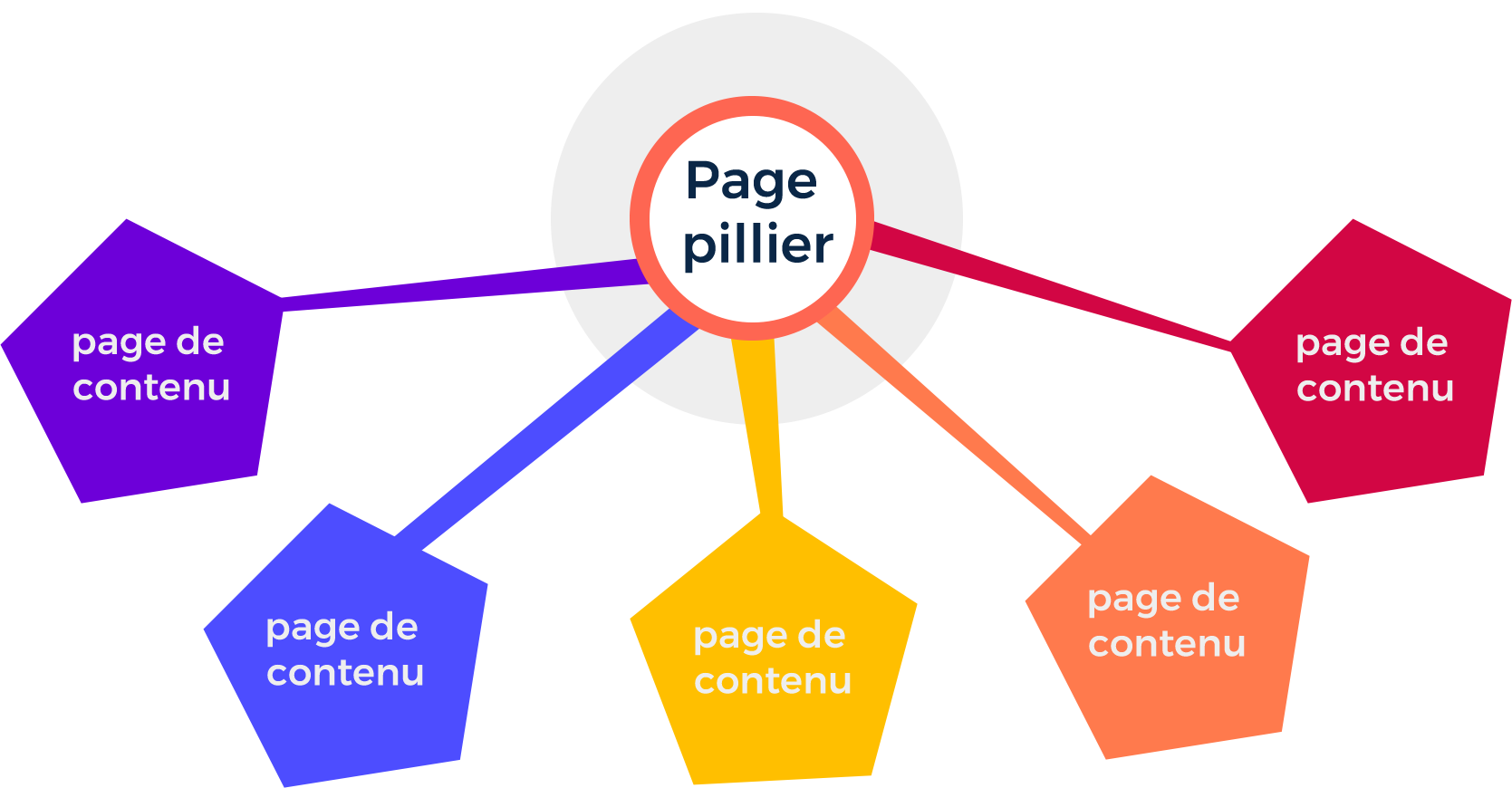
In my opinion, the structure of keyword clusters offers two major types of benefits:
- SEO benefits
- User experience (UX) benefits
🚀 Quick read: what you will learn about topic clusters in this article
In this post, we first remind you of the basic principles of the keyword clustering strategy and how to implement it:
- SEO benefits
- UX benefits
- how topic clusters work
- how to find keyword clustering ideas
Next, you will discover 3 concrete examples of keyword clustering:
- The case of SEOQuantum (B2B)
- The example of redacteur.com (B2B)
- The concrete case of Maciassur.fr (B2C and local SEO)
📈 The benefits of keyword clustering for SEO
Google's goal is to offer users the best content available on a given subject. SEOs use this technique to better rank content pillars, as they are considered more detailed.
Moreover, given the architecture of internal linking, the search engine believes that the more you link to internal pages on a given subject, the more knowledgeable you are on that subject. It is therefore about writing a lot of content on the same theme.
🕺 The benefits of keyword clustering for UX
Keyword clusters allow users to easily navigate your website and discover all your content sharing the same theme, ensuring an interesting and enriching user experience. They allow users to obtain enough details on the subject without having to perform multiple searches.
Now let's look in more detail at how keyword clusters work.
How keyword clusters work
Keyword clusters (or topic clusters) are made up of content pillars and secondary pages belonging to the same thematic group.
- Content pillars: These pages, which can also be sections, cover in detail a broad subject that is essential to the company's activities. They are called content pillars because they address topics that are part of the foundations of your business. These are the concepts from which all the content on your site will derive.
- Secondary pages: These are pages accessed from a content pillar. They provide more in-depth information on the subject. With their own URL, they can also be referenced on longer and more specific keywords. Secondary pages support the content pillar and allow for further traffic and engagement, exploring other key phrases.
💡 Finding ideas for your site's content pillars
Keep in mind that content pillars are conceptual. Thus, keyword data does not necessarily play a role in creating this type of page. Moreover, when it is well worked and has many parent pages, it generally ranks on a whole set of queries.
I always ask myself two questions before designing the content pillars of my clients' sites. Indeed, building this type of structure is done in two stages. I will illustrate my process with several examples of keyword clusters, including one for a client specializing in home veterinary services.
1. Does the pillar refer to your product/service?
There must be a direct link between your pillars and your business. These pillars allow you to create content groups, so it is essential to ensure that the theme has economic value for the company.
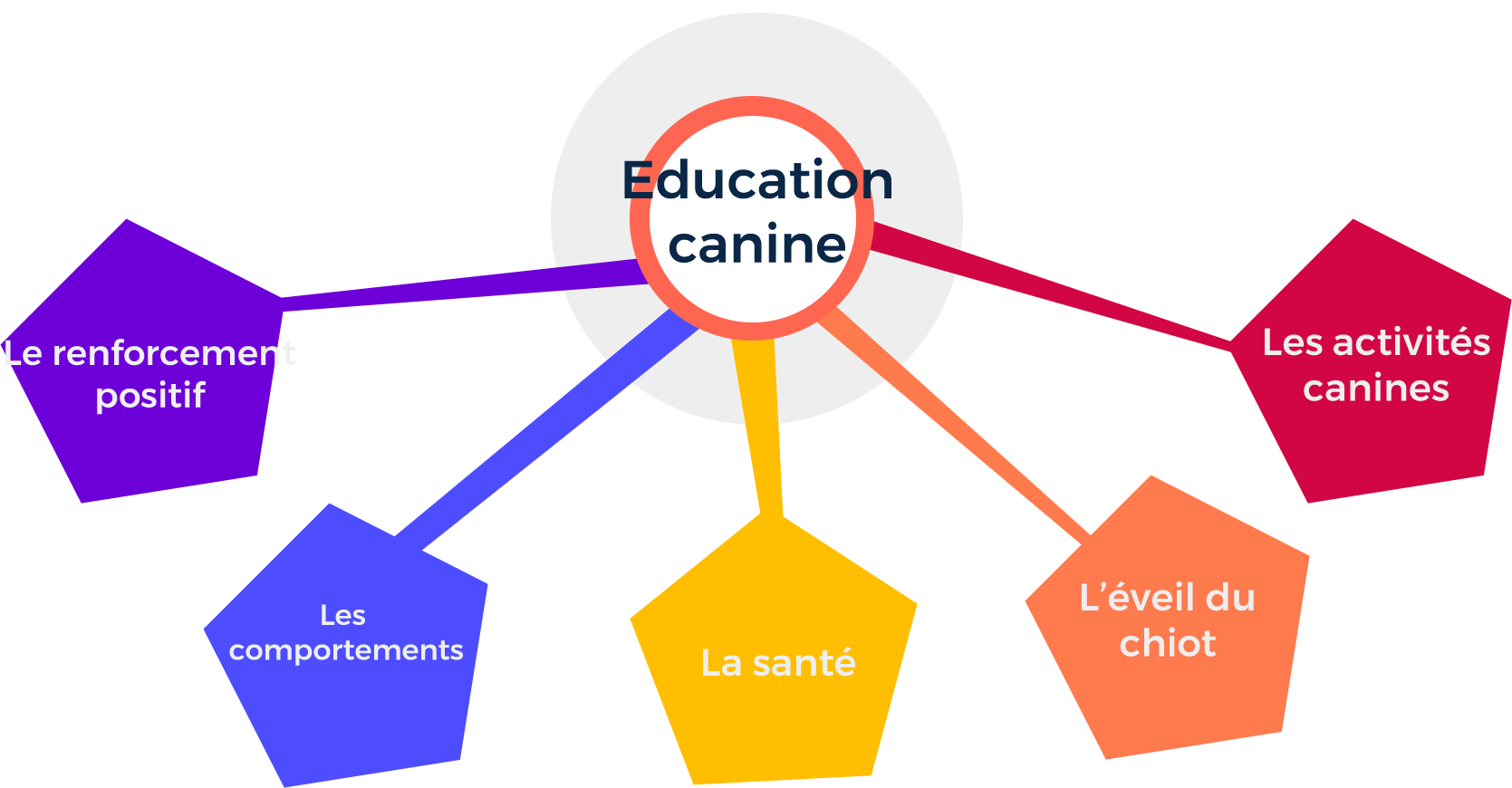
In this case, we relied on 5 pillars that were fundamental to the success of the brand's content:
- Canine activities
- Dog health
- Puppy awakening
- Dog behaviors
- Positive reinforcement (educational method)
Each of these 5 pillars gives us the opportunity to create a lot of content and refer to the brand's services.
2. Does your company have the necessary authority to talk about these subjects?
Google prefers to rank content created by experts. This allows it to ensure the quality of the content it offers through search results. Moreover, I remind you that Google's algorithm takes into account the thematic relevance of the content.
The search engine rightly believes that you should not create content on subjects that have no connection with your area of expertise. Indeed, publishing content on such subjects would mean that your only goal is to increase traffic to your business; it would mean that you have no real expertise in the field on which you create content, and that you cannot help people.
What makes you an expert in the eyes of search engines is the comprehensiveness of your content. Setting up topic groups (clusters) on your site is proof of comprehensiveness.
> However, the concepts related to keyword clustering and how you use them are not uniform; they must change depending on what you sell on your website.
Let's look at this together in more detail.
🎯 Concrete cases and examples of topic clusters
Remember that you must select topics that are related to your product so that your content can attract quality traffic and interested customers. To do this, you must identify the topics that are at the basis of the services or products you sell.
B2B example — tools for SEO
At SEOQuantum, we offer 3 semantic tools: semantic analysis, semantic crawler, and keyword clustering.
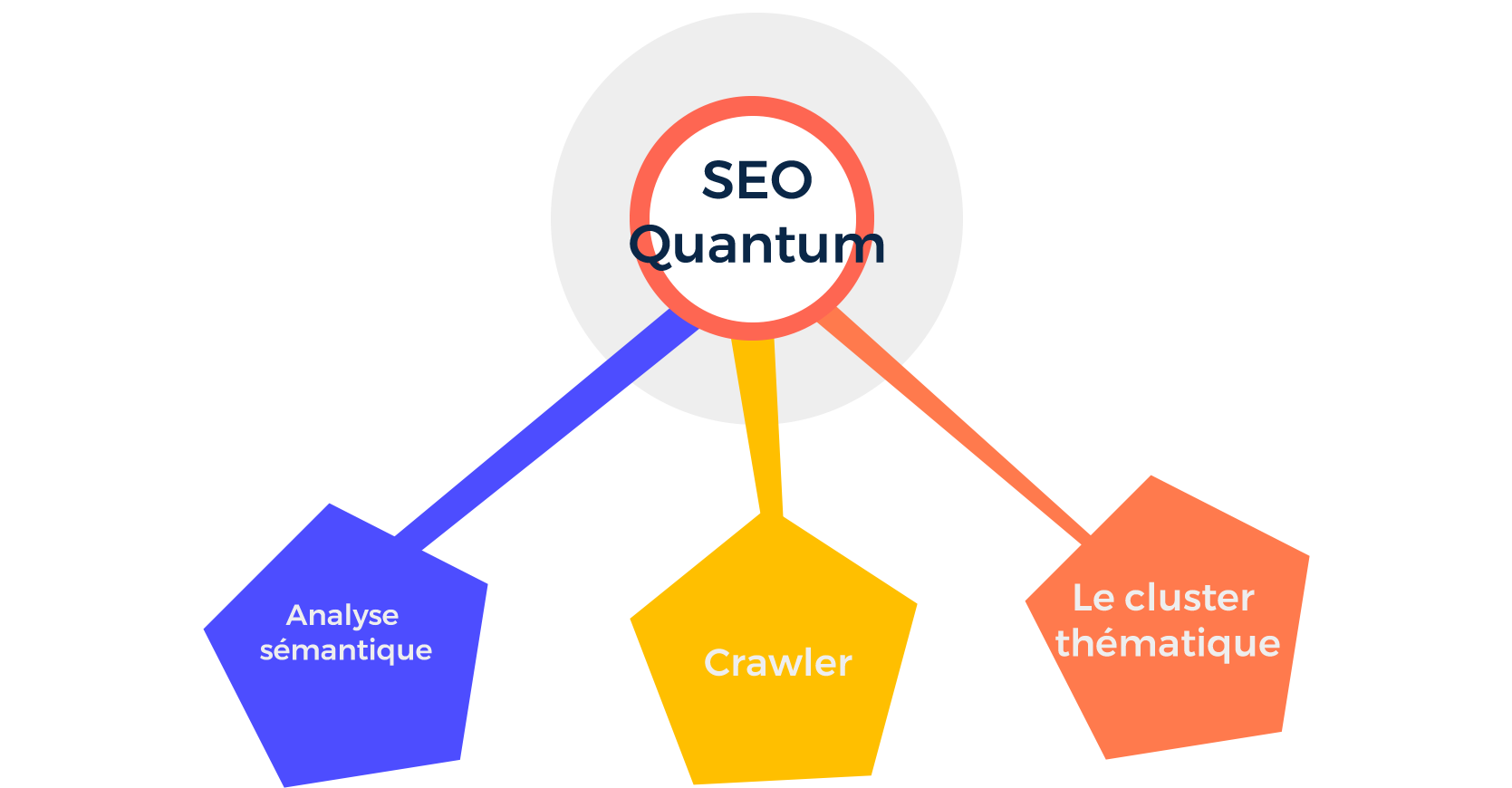
These 3 services correspond to the core of our business, and we must identify the pillars at the base of each of them. In other words, we determine which topics help us generate leads for each of these services.
For example, to create content related to our SEO semantic analysis tool, we must determine what are the main topics related to this theme and what our potential clients want to learn about the subject.
These clients are looking for information on the following concepts:
- Semantic analysis
- SEO content writing
- Content strategies in SEO
- Semantic tool
- …
These concepts all fall under a single pillar, that of SEO content. We have therefore found a pillar corresponding to our SEO services and related topics. But let's not stop there.
To achieve a real SEO boost and better UX, we must create links pointing to all the pages belonging to this group, from our content pillar. We must also link the secondary pages to each other.
It is also important to link to the pages that present the products and services we sell. These pages often use very competitive keywords and are therefore less well referenced. Their interconnection with the other pages of the group will guide potential buyers to the pages that will convert them.
In addition, as we have already mentioned, these links will help us prove our knowledge and authority in SEO content, so that search engines take us seriously.
The SEO crawler and the topics related to it are another linked pillar to our SEO tools. It includes the following concepts:
- Definition of internal linking
- Internal linking strategy
- Pagerank
- …
Again, it is about creating internal links from these pages, our content pillar, and our service pages.
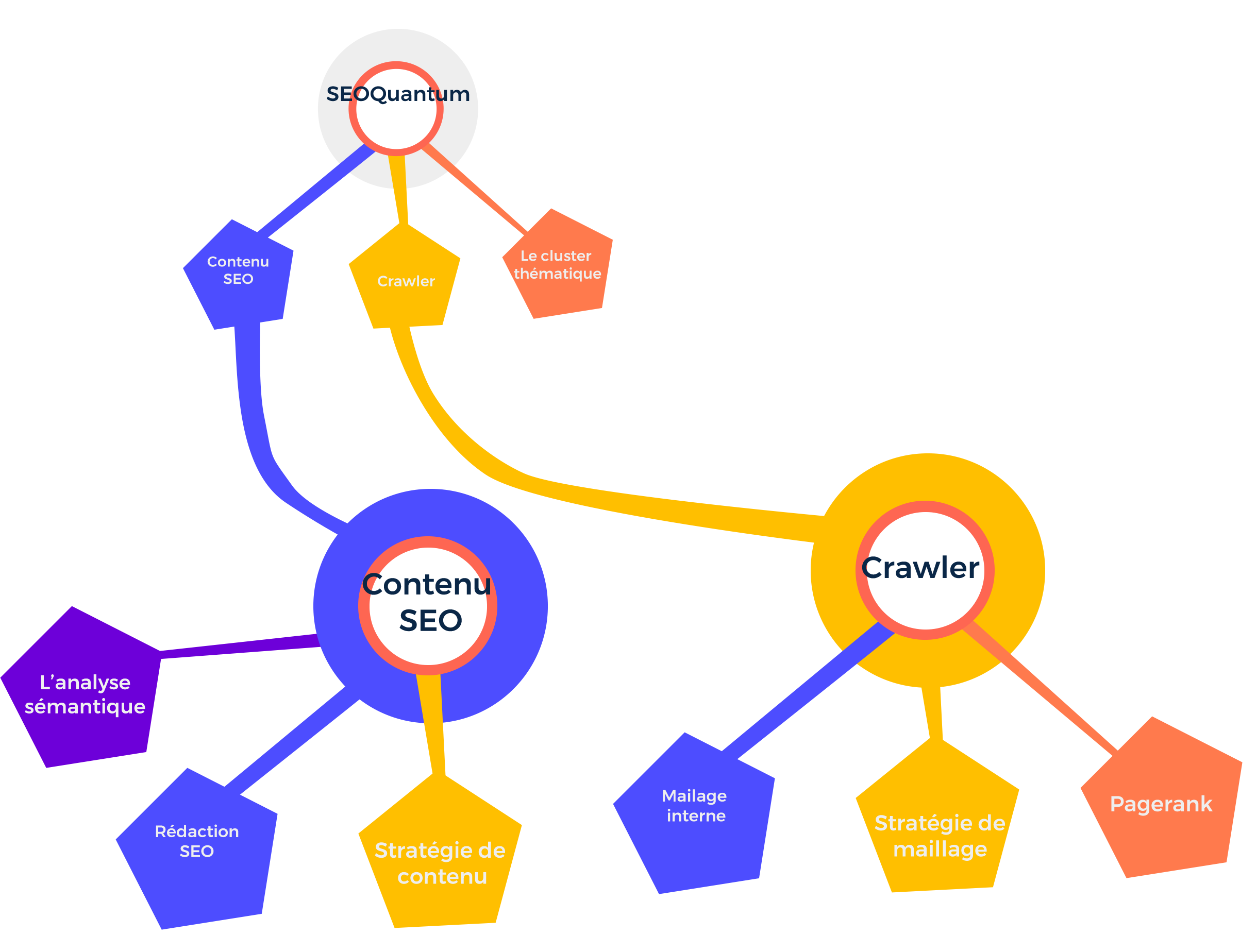
In this example of a topic cluster, we have only covered the creation of content on two pillars: SEO content for our semantic analysis tool and the SEO crawler. These are closely related to our SEO tool pages.
There are several other pillars and topic groups related to these two themes, and with a little research, we can identify them and create content for each of them. Of course, they must all link to our service page to improve their traffic and our revenue.
What results for this strategy?
Now let's talk about SEO results: how has all this helped SEOQuantum rank on Google?
Using the topic grouping model described above, the "semantic analysis" page ranks first. This key phrase generates a volume of 800 searches per month.
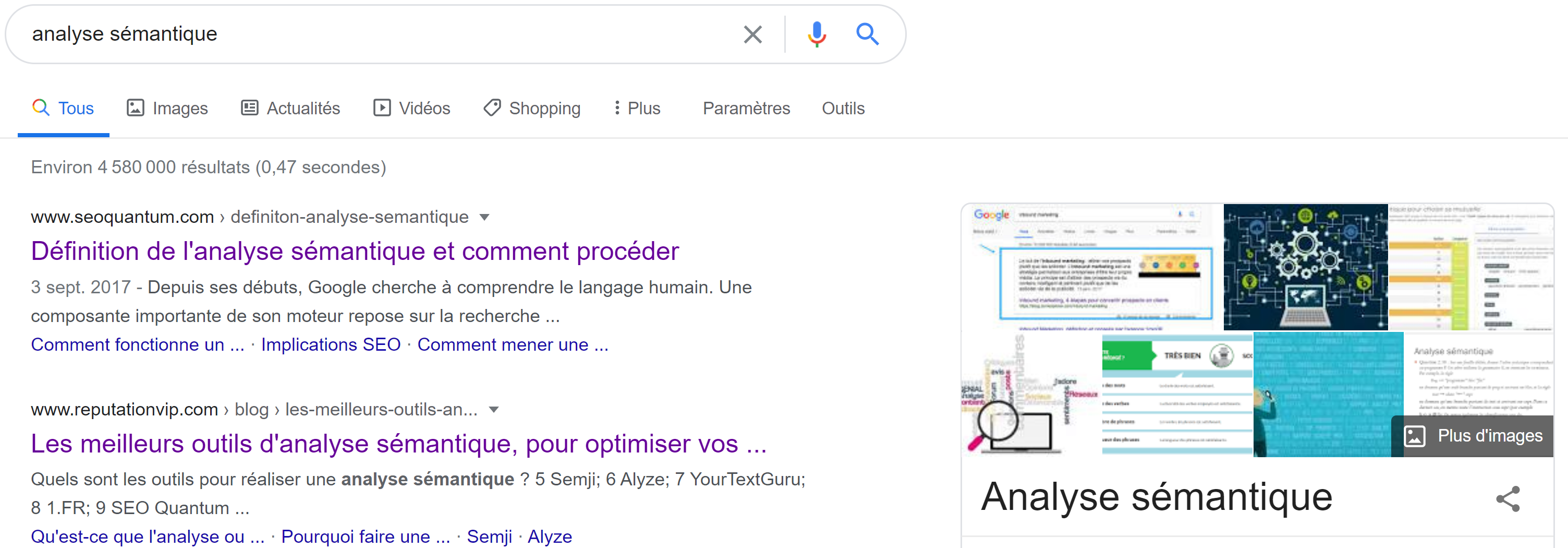
The same goes for most of the keywords in the keyword cluster, SEOQuantum ranks first:
- SEO content
- Web writing
- SEO writing
- SEO content strategy
- …
Not bad, huh? :-) At SEOQuantum, we are proud of these results.
Since SEO is not the only service we provide, we follow the same process to find content pillars and groups that are closely related to the other services we offer, in order to create new content.
B2B example — Case redacteur.com
Imagine that you run an online content writing service. The way we structure topic groups will have to be different. In this case, the B2B services offered are focused on recruiting copywriters/freelancers and corporate clients. These two areas will need to influence the topics of the content that will be created.
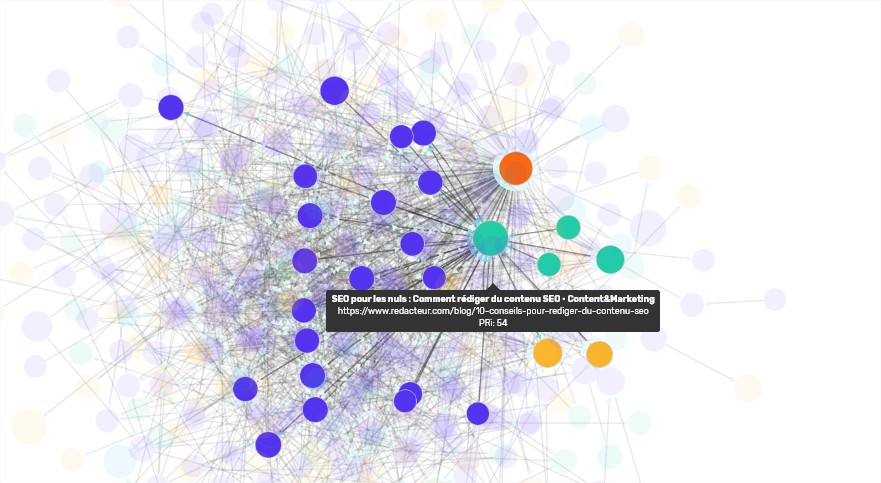
Excerpt from our semantic crawler
It is about proving to potential buyers the effectiveness of the company in content writing and editorial strategy. We will therefore find keyword clusters corresponding to these services.
As part of the content writing service, SEO content is (again) a pillar. This time, as we seek to showcase the company's expertise in content creation and editorial planning management, we will focus on other topics, including:
In light blue pages on semantics:
- Using keywords effectively
- Why semantics are important
- Adapting your content to search engines
In yellow the interest for a company to deploy a blog:
- Blog monetization
- Blog as a traffic source
Finally, in dark blue/purple, pages on editorial strategy:
- Mobile editorial strategy optimization
- Data and content strategy
- White papers on editorial strategy
- 10x strategy method
- …
Again, it will be necessary to link the content pillars and secondary pages.
Example: e-commerce — Maxiassur.fr
Maxiassur is a construction insurance broker that offers insurance through an online quote. This means that the three essential aspects of their business are damage insurance, ten-year warranty, and borrower insurance.
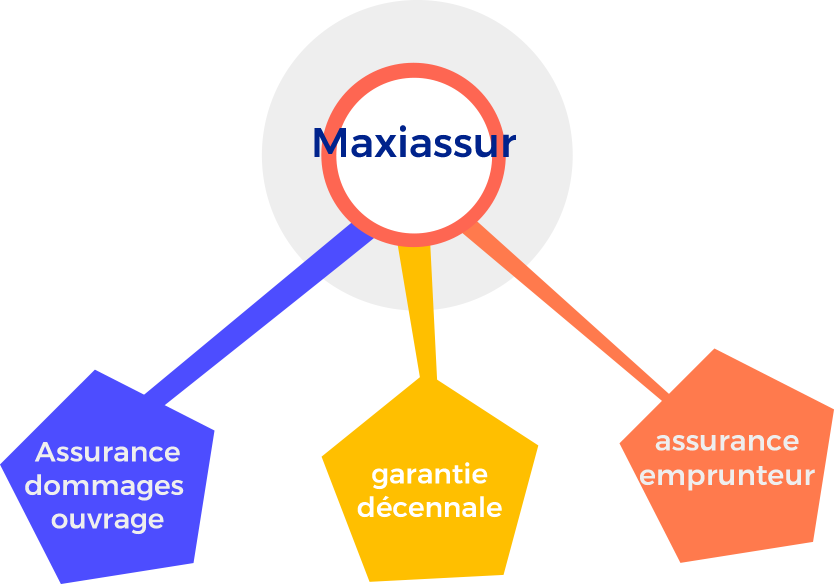
We will explain how they built their keyword clusters around these essential areas of activity.
One of Maxiassur's pillars is the ten-year warranty related to the construction of a work. This is one of their main areas of activity, which is not a problem, as your main areas of activity can be pillars.
The creation of a cluster is very clear with this image with the commercial pages (quotes, prices...) in orange.
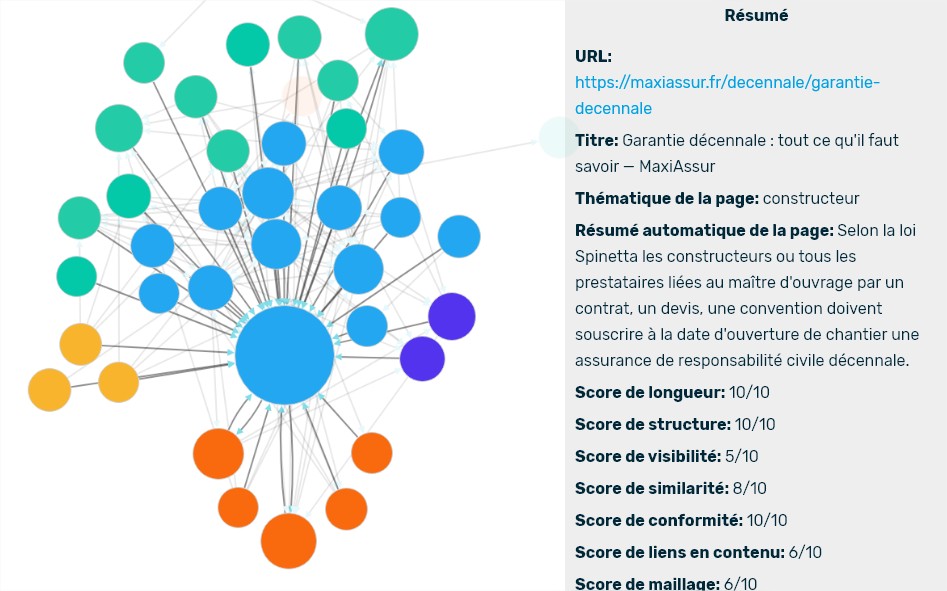
Excerpt from our semantic crawler
The topics identified by our crawler on this subject are:
- Self-employed ten-year warranty
- Craftsman ten-year warranty
- Ten-year warranty for subcontractors
- Ten-year warranty price (in orange)
- …
Let's start by seeing what we would do with SEOQuantum's semantic analysis tool:
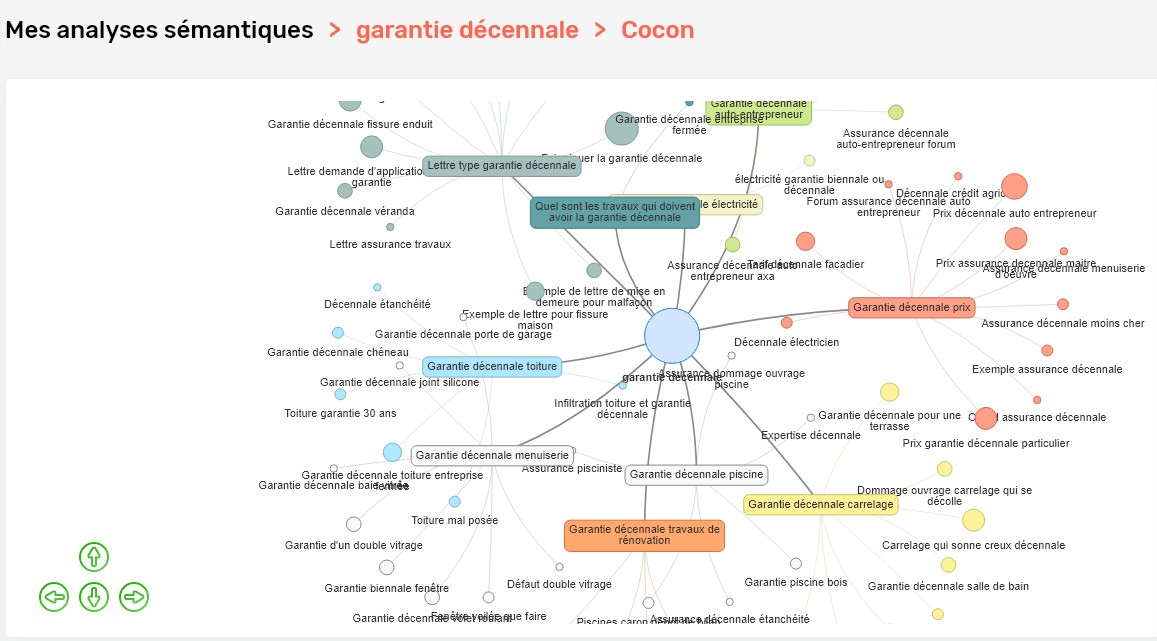
Excerpt from the semantic analysis tool
Once we have identified this pillar, we set up the same process as in the other examples above and find topics connected to this pillar. Among the groups evolving around this theme and not identified by Maxiassur, we can mention:
- Ten-year warranty for roofing
- Ten-year warranty for carpentry
- Ten-year warranty for renovation work
- Ten-year warranty for swimming pools
SEOQuantum also offers additional content to turn your content pages into content pillars. For example, if the level of competition is high on "Ten-year warranty for swimming pools," it is relevant to add the following pages:
- Waterproofing ten-year warranty
- Damage insurance for swimming pools
- Swimming pool insurance
- …
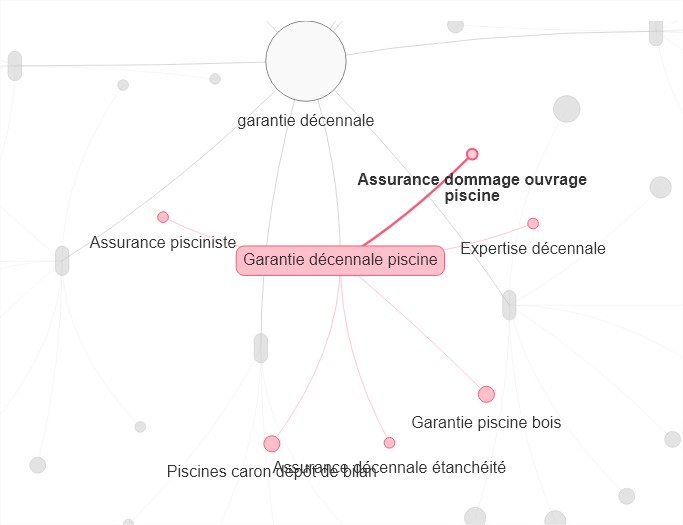
These expressions all belong to the long tail and have a high search volume. They could therefore generate a lot of very relevant traffic for the Maxiassur company.
This traffic may not lead to conversions at first, but it can lead to high conversions through remarketing campaigns or paid SEO (complementarity of SEO and SEA thanks to topic clusters).
Remember that you must also link all these pages to the main "ten-year warranty" page to improve ranking and user experience.
Developing local activity with clusters
Like a Meilleurtaux or Empruntis, Maxiassur wants to develop a national network in major cities (Paris, Lyon, Marseille, Bordeaux) for the "borrower insurance" part. Many physical stores will struggle to generate content that appeals to local customers. So let's see how to generate location-based keyword clusters.
Suppose the brand has physical stores in 4 different locations. In this case, how can we create a content pillar for each of the cities? We must first create subfolders for each of these cities. Each subfolder (slug) will have category pages, and within these categories, we will put content on:
- Things to do in area X (where X is the city where your business is located)
- Interviews and podcasts with local actors
- Upcoming events (shows, activities...) in area X
- Real estate influencers operating in area X
- Event reports
- Local partnerships with banks, the agglomeration...
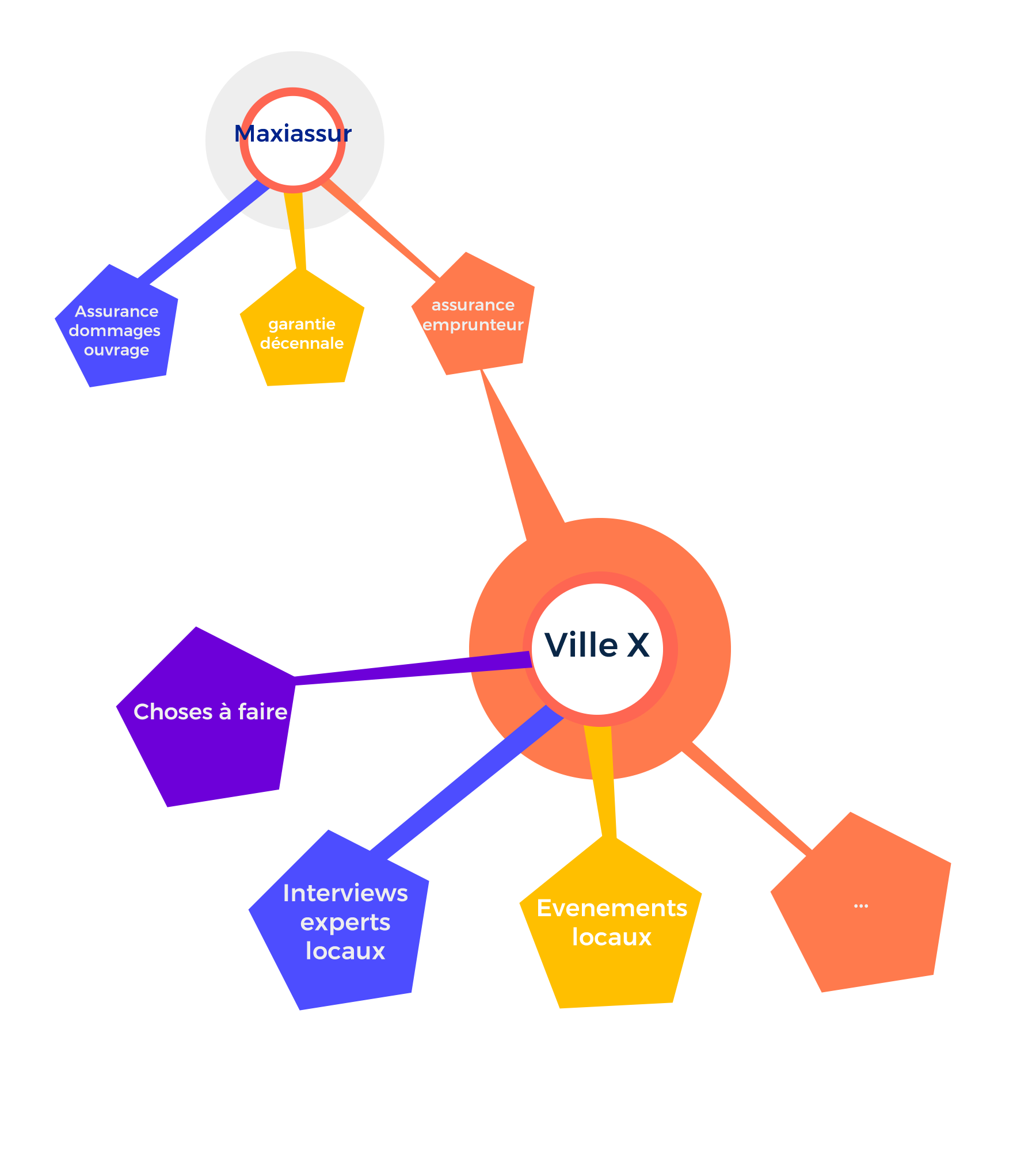
This will allow us to capture the interest of people who like to go out in the areas where Maxiassur's outlets are located.
Subsequently, we can conduct a retargeting campaign on Facebook, targeting people who have read this type of content.
More specifically, we would make sure that sponsored content appears in their Facebook feeds when they are within a one-kilometer radius around the signs with an interest in real estate. This type of campaign works very well.
Of course, we use links to connect all these pages to each other and to the content pillar. Here's a way to develop your clients' local SEO activity!
Keyword clusters help users and search engines navigate your site.
More importantly, your pillars and clusters show that you have in-depth knowledge of your field. Indeed, users and search engines must be able to trust your brand and your products.
Finally, it is important to start building your keyword clusters from the beginning, so that you can develop them as you go along.
It's your turn! Take the example of a keyword cluster that most closely resembles your business. You can do this by taking your time and thinking about all the possible variations... or you can quickly do it with our semantic tool! 😉
Need to go further?
If you need to delve deeper into the topic, the editorial team recommends the following 5 contents:

